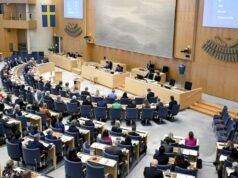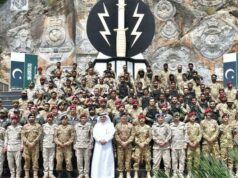Untold Incidences of Operations 1971 Bangla Front
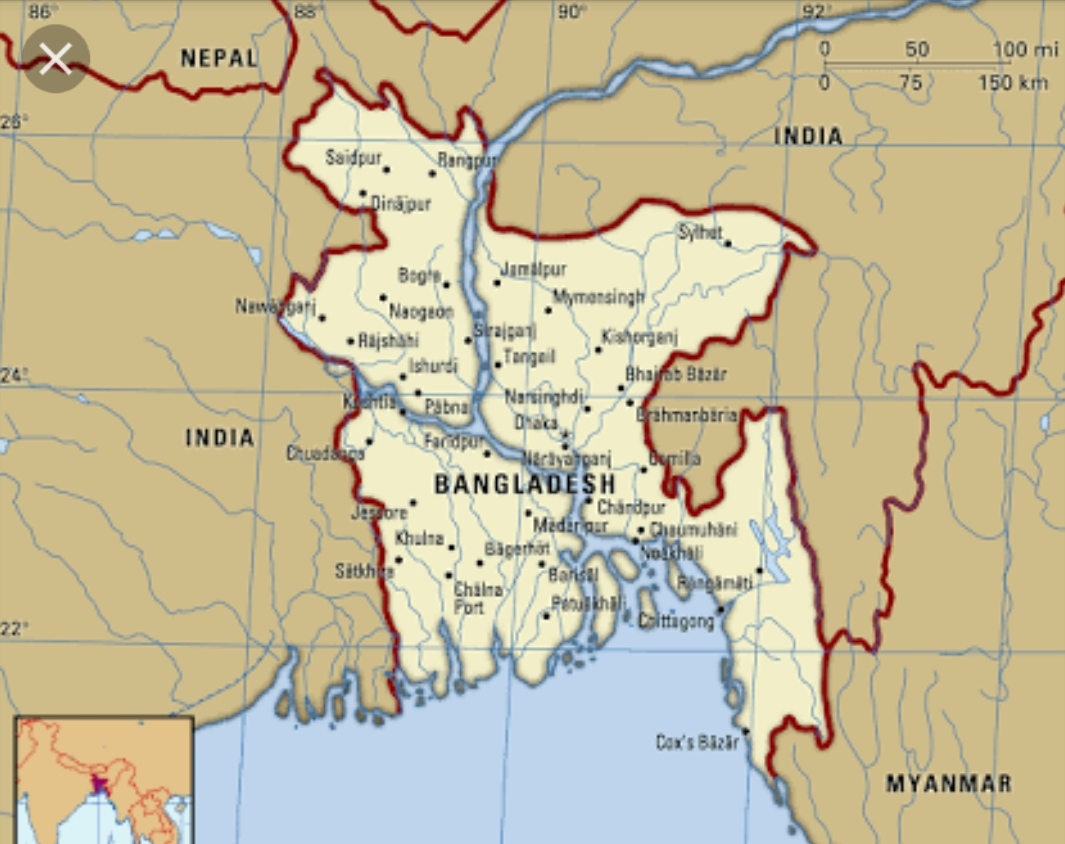
By
Lt Colonel K J S Bakshi, Veteran Engineers
While the build up to 1971 War was going on, it was the 51 Engineer Regiment which was the Divisional Engineers unit of 6 Mountain Division. The peace time Formation deployment as part of Central Command was as under:
Division HQ was located at Bareilly along with most of the divisional troops.
09 Mountain Brigade was stationed at Joshi math with 1stField Company Engineers ex 51 Engineers
99 Mountain Brigade was based at Nainital with 368 Field Company ex 51 Engineers
69 Mountain Brigade was at Dharchula with 100 Field Company ex 51 Engineers
As the preparation of 1971 Operations got underway, HQ Eastern Command made a requisition for a team of Engineers to impart training in field engineering to civilian recruits from the Bangladesh refugees.
Accordingly some time in June 1971 Army HQ ordered HQ Central Command to send a Team of Engineers. Thus on a steamy June night a team comprising 7 officers, 9 JCOs and 15 NCOs from 51 Engineers Regiment boarded the Dehradun Howrah Express and were on their way to Fort William, Calcutta.
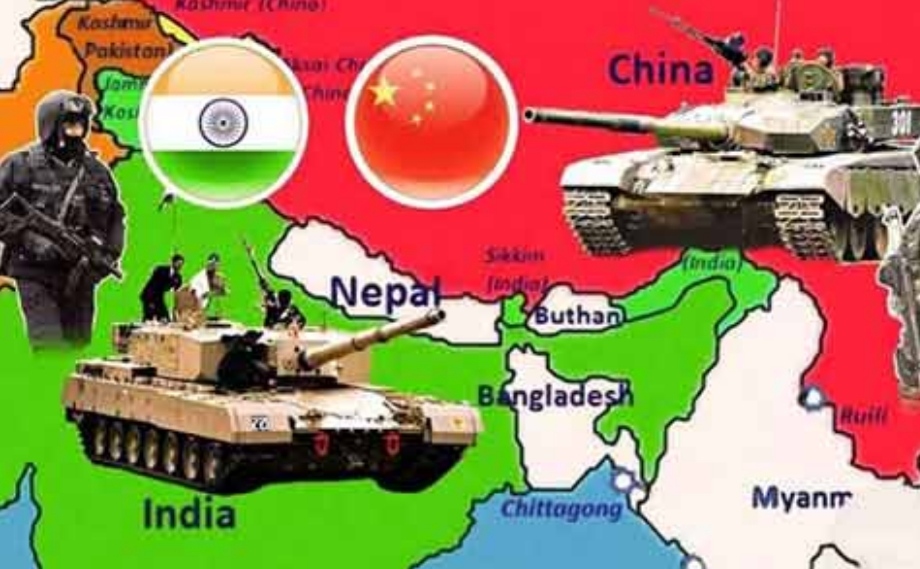
This team was basically required for helping Eastern Command in imparting Training to Mukti Bahani in various Adhoc Training Camps created all along the East Pakistan boarder. These camps functioned under 10 newly raised Ad hoc Sector HQ namely Alfa,Bravo, Charlie, Delta, Echo, Foxtrot, Golf,Hunter, Juliet and Kilo.
I, Lt KJS Bakshi was serving in 1 Field Company which had recently moved from Joshimath to Pithoragarh. Rest of the 9 Mountain Brigade had moved to Chamoli / Pipalkoti Area due to heavy floods and land slides at Joshimath. Then suddenly orders came from HQ Central Command for my move to Eastern Command Theatre with a designated party of Engineers.
Accordingly I moved with the above Instructional Party to report to HQ Charlie Sector based at Barrackpore. Charlie sector was being commanded by Brig Salik of (Paras) and his Brigade Major was Maj Shankar Roy Chaudhary an Armoured Corps officer who later become Chief of Army Staff.
I reported to Charlie Sector somewhere in Jun 1971. Immediately the BM assigned me a task to identify and collect all the vehicles which had come across from East Pakistan into Charlie Sector area and had been seized by Civil Authorities. All such vehicles in the sector were to be brought to the Central military pool which was located in Barrackpore.
Therefore I had to go around all the District HQ’s and after meeting various authorities e.g. DMs and RTOs and without much difficulties was able to muster around 100 different Vehicles, comprising Trucks, Jeeps, Vans, Motorcycles and even Mopeds. Both Brigade Commander and the BM were quite pleased by this outcome.
After this work which took a fortnight or so, I was sent to the Sector Training Camp at Chakulia which had an Old abandoned Air field of Second World War vintage. Chakulia is located between Jamshedpur and Kharagapore.
This Training Camp for training the Mukti Bahani was under the operational control of ‘C’ Sector and Commanded by Lt Col Das Gupta of Mahar Regiment who later rose to the rank of a Lt General. We began our task in earnest. Whereas others taught these Bahani chaps the basics of Section Level military tactics and guerrilla warfare tactics, I was a responsible for imparting Instructions to Mukti Bahani in the basics of Field Engineering Tasks.
Prime requirement of guerrilla tactics being basic handling of Explosives for blowing up railway lines, felling of trees, creating craters or defiles on roads, laying of mines, anti tank, anti personnel, fragmentation mines with Booby Traps and also the use of Claymore Mines. To blend in with the Bahani and to hide our Identities from the general local civil population in the area, all the Instructional Staff wore Khaki uniforms instead if Olive Green Army Uniform.
Further all Officers were issued with confiscated vehicles such as motor cycles, vans or jeeps, which had come across to India from East Pakistan.Our Commanding Lt Col Das Gupta was having a Blue Colour Toyota Jeep (self Driven)and I was issued with a Toyota make Moped. Fuel for the vehicles was issued by the QM store and we all used these vehicles to go to the training areas and firing ranges to conduct various training classes for the Mukti Bahini.
Captain Alexander was an Special List Commissioned Officer who assisted the Commanding Officer in the HQ by performing the combined duties of Second In Command and Adjutant besides his own duties of a Quarter Master.
The Mukti Bahani cadres under our Unit were divided into Groups, with each Group comprising approximately 60-80 personnel. To help us out, we had a few Bangladeshis Chaps in the Mukti Bahani who had Army, Para Military or Police background and who had joined the Mukti Bahani and formed its core.
These service personnel were quite versatile and were utilised by us as translators and demonstrators while imparting Instructions to the rest of the Bahini. Myself and my Instructional Staff first Conveyed all practical instructional steps to these men and they in turn translated everything to the rest of the Group in Bangla of the East Bengal variety.
This way the rest of the Bahani use to pick up things faster as they got things explained to them in their own language. In spite of being a laborious process, it worked wonderfully. Mind you, the Bangla spoken by these East Bengalis seemed very different than one spoken by West Bengal people, at least to me a Sikh brought up in Agra.
Most of the Mukti Bahani personnel were from rural areas of East Bengal and generally economically not well off and thus were unable to understand Hindi or English and could only understand Bangla Dialect of East Bengal only. Many had come from interior villages, who had not attended any schools. Hence these Translators/ Mediators were of great help to us.
SUCCESSFUL GUERRILLA TRAINING
One day I was called by the commanding Officer and asked to carry out the trials of firing a Rocket without using the 5.5” Rocket Launcher. Knowing that the Rocket is triggered off by the electric current which is generated when the trigger of the Rocket Launcher is pressed, I took a Live Rocket, placed it on the Ground about 100 meters from the selected Target. After aligning the Rocket towards the target, I took laying position on the Ground next to the rocket.
There after I joined two Flexible wires of 100 meters each to the two screws on top of the rocket. After joining the wires, I along with a NCO of mine moved back further 100 m with the wires to a trench. Thus now we were about 100 meters away from the live rocket and about 200 m from the Target.
Next on my orders the two wires were to be connected to a Dry Cell Battery ( Army issue) of 12 volts. The target selected was nothing but just a big circle of 10 ft diameter marked on the earthen bund. Once every thing was ready, I connected the second wire and the rocket roared towards the target and hit it bang in the middle.
We conducted a few more such firing Trials. Each time the Rockets were able to hit the Target bang at the desired place. This was a great achievement and a big force multiplier.
Using this method firing of rockets were no more dependent upon the Rocket Launchers which were quite limited in number. Thereafter this new firing method became our standard Teaching Drill for the Mukti Bahani in our Camp.
As our trained batches moved on to the borders for live raids into East Pakistan, we started getting reports from various Battalions deployed on the Border Areas regarding employment of our tactics.
Mukti Bahani personnel trained by our Camp were issued With Rockets, 2oo meters of Electricity Flexible Wire and a 12 Volt Dry Cell Battery for each by the Indian Army Units. The guerrillas carried these in Bags / Thelas deep into East Pakistan and were able to damaged many Enemy Boats/ barges / trucks and variety of other targets very successfully thus causing real panic among the Pakistanis.
MOVE OF 9 MOUNTAIN BDE
9 Mountain Brigade depicting itself as complete 6 Mountain Division moved out along with its Adhoc Divisional HQ to Binaguri location in the month of October 1971 and came under command HQ Eastern Command. This was a Deception Role move to come under Eastern Command. 9 Mountain Brigade had the following units under command :-
- 4 RAJPUT
- 5 GRENADIER
- 4/8 GR.
- 1 Field Company (Engineers)
69 Mountain Brigade ex 6 Mountain Division located in area Dharchula (UP Tibet Border) was made to also hold 9 Mountain Brigade area of Joshimath. Whereas 99 Mountain Brigade and Div HQ remained at their respective locations i.e. Bareilly and Nainital.
By early November in 1971, Pakistan had begun to carry out unprovoked shelling on Indian villages along the International Bangla Border. Heavy influx of refugees had already been there ever since the crack down in East Pakistan in March71. When things became unbearable, Indian Army decided to take not only punitive action but also preliminary action prior to the main offensive to liberate Bangladesh. Aim was to bring a halt to the constant artillery shelling by the enemy and at the same time to make the situation favourable for an advance in the Southern Direction into East Pakistan when the time came.
Thus 9 Mountain Brigade acting as 6 Mountain Division came into action even before the main war was declared on 03 Dec 71. They had been tasked to carry out aggressive patrolling, firing, simulating attacks and even raids as Provoking Action on East Pakistan Border Units. Action commenced sometime in early Nov 1971. After assembling at Cooch Bihar ( West Bengal ) the “Division “ moved up to the Northern Border town of East Pakistan under command of Brig T S Verma of Gurkhas ( later Lt Gen ). 4 RAJPUT was commanded by Lt Col P L Kukreti ( later Major Gen) and 5 GRENADIER was commanded by Lt Col Mahavir Singh. 1 Field Company was to provide close Engineers Support to the formation. Adequate artillery and other supports were made available by HQ Eastern Command.
“ 6 Mountain Division “ then entered East Pakistan from North that is DINAHATA area of Cooch Bihar in West Bengal to the International Border and then to BHURUNGAMARI a small town Ship in Northern Part of East Pakistan. There after the aim was to progress its March and Operations towards RAIGANJ, NAGESHWARI, CHANDIPUR and KURIGRAM. The route thus ran from Northern part of East Pakistan towards South.
Many a battles and skirmishes were fought by 4 RAJPUT and 5 GRENADIER with Close Support of 1 Field Company Engineers. Each time the Formation achieved victory and kept moving its Firm Base forward along the planned axis …. DINAHATA to BURANGAMARI, thereafter to RAIGANJ once it was Captured. Soon the enemy too reorganized itself and put up a very tough battle at Raiganj.
They used intensive artillery to bombard our troops with plenty of air burst shell inflicting heavy casualties on our side. An operation was then under taken to destroy enemy guns in the general area of CHANDIPUR.
However the area was very well fortified and heavily defended with adequate Ammunition Stocking. As a result though our attack failed to dislodge the enemy at CHANDIPUR, it resulted in shaking the enemy Morale quite badly. Due to the ferocity of our attack, the enemy started a planned Withdrawal on its own to its Rear positions located at KURIGRAM.
So by the End of Nov 1971 Our Company had moved to a place called ANDHERIJAR, located on Main Axis towards KURIGRAM to support the Formation for the battle of KURIGRAM in the rear future.
However when the hostilities commenced officially on 03 December, 9 Mountain Brigade with Support of Field Engineers 1 Field Company, was tasked to move out not using the Main Axis but to take a detour and open an alternative axis….. AMTALA …….BHOTIMARI …… LALMUNIRHAT located North of River TISTA. Our Company opened this Axis AMTALA – BHOTIMARI by using Dozers and local resources.
Many Causeways of bamboo Matting were made overnight by thus enabling the Gunners to drive their Craz Vehicles with Guns in tow. By now the Pakistani Army was on withdrawal mode. Our forces had total control of RANGPUR and DINAJPUR.
After the declaration of War on 03 December 1971, all the Adhoc Sector Training Camps were ordered to be closed and the Instructional Staff returned back to their respective units. So I was ordered to report to HQ CHARLIE Sector at BARRAKPORE. From there I had to move to my Parent Unit 1 Field Company now located at a place called BALURGHAT. I was finally able to join my 1 Field Company on night 7/8 December 1971 at BALURGHAT.
BRIGADE RAID AT CHIRIBANDER
By this time East Pakistan Cantonments of RANGPUR, DINAJPUR, were under total siege by our Forces, which had advanced South wards into East Pakistan. This had put Lots of pressure on the defending Pakistani Forces. Even the Air Battle had been lost by the Pakistanis with the PAF being wiped out of the skies in the initial stage of the War only. Pakistani Army was soon avoiding heavily pitched battles with our Army and was in a total Withdrawal Mode in order to save Dacca.
So the Corps HQ planned to cut off the enemy’s route of withdrawal by destroying an important rail bridge in their rear near CHIRIBANDER Railway Station. In consonance with this plan of the Higher HQ, our Formation HQ decided to infiltrate an infantry Company Group with elements of Engineers to Blow up the CHIRIBANDER Railway bridge.
The Engineers in addition were also tasked to lay Mines/ and make Craters on Northern Side of the Bridge where a Ferry Site was located for river crossing. A road existed on both the banks but there was no Road Bridge connecting them. Thus over all aim was basically to prevent the Enemy from transporting back their Major Stores / Equipment by the Railway link between their two major Cantonments of DINAJPUR and PARVATIPUR.
Accordingly 9 Mountain Brigade from RAIGANG – BALURGHAT – GANGARAMPUR – SAMJHIA West of HILLY Area where a pitched battle was fought and after lots of resistance the Indian Army had finally sieged the Hilly Area.
12 GARHWAL Rifle ( Newly Raised ) came under Command of 9 Mountain Brigade. One Company of 12 GARHWAL was tasked to lead the raid along with elements of Engineers. This raid party was allotted two Platoons of Engineers.
One Engineer Platoon was assigned to blow up the bridge and the second Engineer Platoon was to make road craters for preventing vehicular traffic and also to lay mines on the Ferry Site.
This job of lying of mines and making craters were assigned to my Platoon and blowing of bridge was assigned to the Platoon Commanded by Capt Rahul Kar. We both were under command Company 12 GARHWAL being Commanded by Maj Paul. He had recently joined the newly raised unit on Raising, from IMA where he had been posted as an instructor.
BRIDGE DISCRIPTION
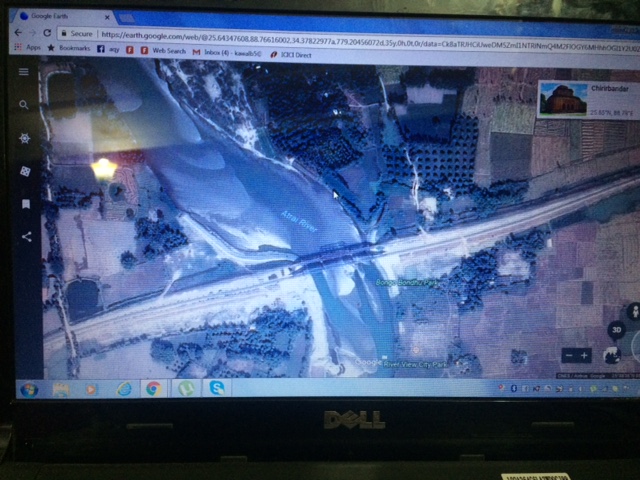
The Rail Bridge was located on River ATRAI. It was a Hamilton type bridge half under Slung. The four spans of the bridge were 25 to 30 meters each. This bridge had been constructed by Jessop And Coy from Calcutta in late 1870’s. The bridge was located approx 1 Km West of CHIRIBANDER Railway Station. The route to the bridge was along a side Track on River KARATOYA. It was at the distance of about 12 KMs from the Front line. There was Rice Mill located on the South East side of the bridge and quite close to it.
THE PLAN
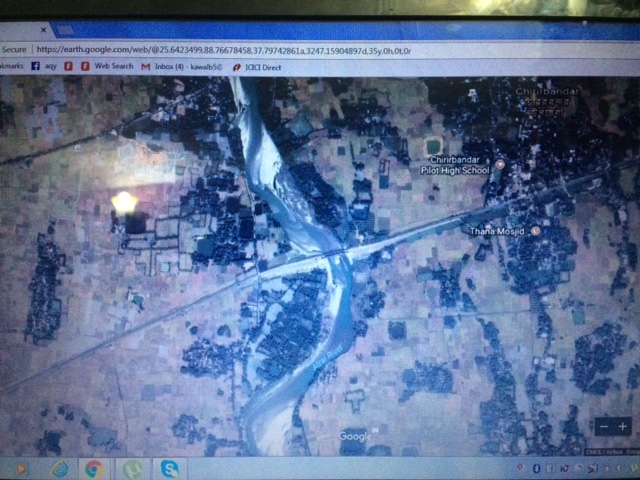
The Raid was planned to be carried out on night 10/11 December 1971. The raiding force was to move from SAMJHIA – KUMARGAON – CHIRIBANDER on Eastern Side of R – ATARI ( Later this River meets KARATOYA ). The home bank was to be secured by the infantry company with one Engineer Platoon. My Platoon was to provide fire support. There after my Platoon was to go on the bridge and get through to the other bank and secure it. Then the first platoon Engineers was to carrying out the bridge demolition. Whereas I was to proceed to the Ferry Site (Located on the Western Bank of River Atari) about a 1Km from the bridge, and carry out road cratering and laying of mines on the Ferry site. The raiding party up after completion of those tasks were to return by 1st Light on 11 Dec 1971.
THE RAID
The detail orders for the Raid was given out by the Company Commander Maj Paul at 1600 hrs on 10Dec 1971 on a Battle Field Sketch. The Information available pertaining to enemy strength and on technical aspect of bridge to be blown were basically NIL. Hence all our planning was based on assumptions.
Infantry Company lead by Maj Paul was to attack on home bank (eastern side of the bridge). ‘B’ Platoon under me was to give a supporting fire while the raid / scanning of Home Bank was to be conducted by the infantry company.
’A’ Platoon of Engineers under Capt Rahul Kar was to follow the infantry company. My Platoon was to take position in Area Depression on the East Bank from where we were likely to have a full View of the Home Bank of the bridge. In my Platoon we were holding only One LMG which was held by L/Nk Jawala.
The load tables of each member of Sapper Component was quite heavy. It included explosives and accessories required for demolition of bridge. These were being carried by ‘A’ Platoon Personnel under Capt Rahul Kar. They also had carried Beehive shaped Explosive which was supposed to be used for blowing up of Abutments. ‘B’ Platoon under me carried Explosives for making craters; also we carried enough variety of Mines, Anti-Tank, Fragmentation and Anti-Personnel to be laid at the Ferry Site.
Over and above, both the Engineers Platoons carried excess load as contingency, to ensure that we are not found wanting in our capability to deliver, once the Clearance was given to demolish the bridge and completing other Engineering tasks.
The infiltration march commenced on foot at about 1900 hr on 10 Dec 1971. It was very cautious tactical advance, which took us near the Objective by about midnight. The complete Infiltration party took position in and around the Rice Mill after ascertaining that no one was occupying it.
We three Officers and few Key personnel in the Raid Party then went to a vantage point so that the bridge and the activities of the enemy could be monitored.
The night was a moon lit and we could see the sentries patrolling and we could also see the bunkers as the Railway line was laid on the Abutment and was on a higher ground than the surrounding area.
Far bank of the river and the bridge could also be seen clearly. one could even hear some voices coming from inside the bunkers and a even little light was seen percolating from some of the bunkers.
After recce it was decided that main attack should be launched on to the near bank where we could see the patrolling sentries. My Platoon took position to provide the Supporting Fire.
The Infantry Company mounted the attack on the bunkers and Capt Rahul Kar with his Platoon followed the main body. As the Garhwalis reached near the bunkers one of the enemy sentry spotted them.
However by the time he could raise his rifle to fire, he was shot dead and then there was total chaos. For a minute there was heavy firing and shouting and then the Garhwalis charged and within no time our troops had captured the near bank and reached the bridge and quickly secured the area.
I after ordering my Platoon to stay deployed in situ, moved up to the bridge with two of my men. I met Maj Paul to discuss the next move. There I saw that the Garhwalis had suffered 3 casualties but luckily all wounded only.
To complete the task assigned to me, now I along with my Platoon was to proceed to the Far Bank secure it and then go to Ferry Site which was further 1Km away down the far bank of the bridge.
To secure the far bank, Major Paul was to provide me with half strength Infantry platoon. This platoon would also provide Supporting Fire to cover my move to the ferry site.
Accordingly, Maj Paul placed one of his platoons under my command and then gave me orders to attack and capture the Far Bank and then only proceed to the Ferry site. Soon I had my Platoon of about 20 Sappers with Stores forming up for the move along with one Havildar and 15 men from 12 GARHWAL Then as soon as we commenced the move for our mission on to the Far Bank, the enemy started firing on our position along with that even his artillery opened up in earnest. At once my men took positions on the ground around the Abutment and the Railway line. Enemy firing became quite heavy and continuous.
In the meantime, Maj Paul also called for artillery fire support, which was accepted by the Formation HQ at once. Immediately our Medium Artillery Guns started belching out their shells in quite a concentrated volume.
With just one correction, given by Major Paul, the artillery just zeroed bang on the enemy. The impact of the shelling was immediate. The enemy got disorganised and was soon seen to be withdrawing from their defensive position in haste.
Seeing that my move to the Ferry Site was now going to be delayed, I along with my Platoon decided to move in and provide support to ‘A’ Platoon under Capt Rahul Kar in preparing the bridge for demolition.
Presently I saw only Capt Rahul Kar and his Sahayak Govind Singh preparing demolition charges for the destruction of the bridge. This was because all others including his Platoon JCO Jasmer Singh were still under the bridge, waiting for the artillery fire to lift.
They had gone down immediately after the capture of the bridge to carry out engineers recce for demolition. So I went down myself and got hold of ‘A’ Platoon and brought them up on to the bridge.
Now we had both the Platoons working together to get the charges ready for the demolition task. The bridge was much bigger than what we had anticipated. However now we had adequate strength to complete the task.
Then as we were preparing the bridge for demolition, it dawned upon us that we may face shortfall in explosives to blow up such a huge bridge. So we decided to use all the explosives being carried by my Platoon for making road craters as the priority for the Engineers Platoons was to first blow up this bridge.
Soon the bridge was prepared for demolition. Being a moon lit night, there was enough visibility to help us in fixing the charges to the abutment and the girders. Even the intermittent enemy small arms firing from very far off was unable to distract us.
By that point of time all our men were quite used to such Small Arms fire. So without any disturbance we could complete our Job in fixing up of charges on to the bridge. Finally we were ready and it was reported to Maj Paul.
He then asked for the express permission of the Formation Commander himself for blowing the bridge. After getting the GO signal We triggered it off but to our utter dismay the bridge did not come down.
By now it was dawn about 5 A M in the morning. We began examining the bridge and were quite relieved to see that only a very number of Iron Girders were left enact. Thankfully around this time some one had discovered that a few bunkers were full of explosives.
Also at places on the bridge the Pakistani’s had fixed up the explosive to blow up the bridge. So most probably Pakistanis had also earmarked this bridge as a Reserved Demolition to prevent our rapid advance along this axis.
Soon we fixed up more charges on the remaining girders which were still intact using Pakistani Explosives and then blew up the bridge. The Home Side Span of the bridge came down tumbling.
At this point it was early morning of 11 Dec 1971. We were told by the Formation HQ to hold on to the bridge site instead of exfiltration as planned. Thus the Raiding Force engaged it self in preparation of our defences, which included reorientation of enemy bunkers and trenches to suite our requirements.
There was a huge quantity of rations left behind by the enemy so there was no shortage of food for any extended stay in location. Also the Mukti Bahani elements soon contacted us and they flooded us with rations and whatever required.
Since we were to hold on to the bridge till next orders, few Patrols were sent by Major Paul all around the Bridge Area. One of the Patrols saw some movement in the Rice Mill Area and reported. I was ordered to go and carry out further recce. I along with the Patrol Leader proceeded to the site near the Rice Mill.
Suddenly some movement was detected and one Pakistani Jawan who had been hiding in the Rice Mill after the night attack on the bridge, jumped into the River ATRAI and tried to swim across to the far bank. I fired a few rounds on reflex and one round hit him. His body came up and started flowing down the river with the fast current. Though I did not feel elated at this event, there was no other emotion also.
Thereafter, a few hours later on 11 Dec 71 morning I with my Platoon and a platoon of Infantry in support proceeded to the Far Bank to lay mines on Ferry Site and also make few craters on the road leading to the Ferry Site.
There was some intermittent fire coming from enemy side but from a great distance. Our men by now were quite used to such firing. We completed this task without much of difficulty, using the Pakistani Explosives.
While we were returning after completing the tasks on the Ferry Site, we observed that about 300 Meters away from the far bank of the bridge, there was some kind of groaning noise.
On approaching the area to my surprise there was one Pakistani soldier from their Engineer Regiment who was now trying to hide himself in the bushes. He was actually incapacitated with leg injuries suffered when our troops had thrown grenades into the enemy bunkers.
By now his injuries had already got infected and I could see even insects crawling on the wounds. We removed him from there and after giving him first aid ensured evacuation to the rear as a wounded Prisoner of War.
In fact, this Sapper from 13 Engineer Regiment of Pakistan Army, informed us that this bridge had indeed been earmarked as a Reserved Demolition and that is why we found so much of explosive in their bunkers. This raid in fact was a real surprise for them. Initially they were thinking that they had been attacked by the Mukti Bahani and not by the Indian Army.
As our stay got extended, Major Paul decided, to make the area more secure by extended patrolling. I was detailed as Commander of a Party with mixed Troops from Infantry and Sappers.
On 14 Dec 1971 at about 2 PM, I took One JCO and 20 Jawans with 2 LMGs and adequate ammunition and proceeded towards Chiribander Railway Station, the nearest township from our location at the Bridge.
The distance was about 1.5 KMs from our location. We were anticipating some enemy resistance at Chiribander Township. To our surprise we found No resistance was coming and we reached the Railway Station. We deployed all around the Railway Station.
Then as souvenirs we removed two Ticket Punching Machines which were fixed with nuts and bolts on the Counters. We collected these machines as Mementos for our Regiment. After staying on the Railway Station for almost one hour, we withdrew to our location at the bridge. It seemed that the Pakis were in no mood to put up any resistance whatsoever.
In the meantime, while Patrolling around the bridge area, on 14 Dec 1971, a Patrol encountered two Razakars (Supporters of Pakistani Army), they were armed with just one 12 Bore Gun. These two Razakars were caught and the weapon confiscated by our Troops. The two Razakars and the weapon were despatched to the Base Camp at SAMJIA under escort.
On 16 December 1971 after declaration of Cease Fire the war officially came to an end. However we still had to be fully alert. Soon civilians from nearby villages along with Mukti Bahani came out and approached our location. We were a bit apprehensive but they all seemed to be in a Jubilant mood and celebrating their freedom. They offered us many presents and piled us with fruits, vegetables, live Lambs, goats and poultry and other cooked food Items.
Soon came the orders for the Raiding Force to withdraw to 12 GARHWAL main position and we were thus able to join our Engineer 1 Field Company at BALURGHAT. On 20 Dec, 1 Field Company further moved to join the Regimental HQ at BINNAGURI.
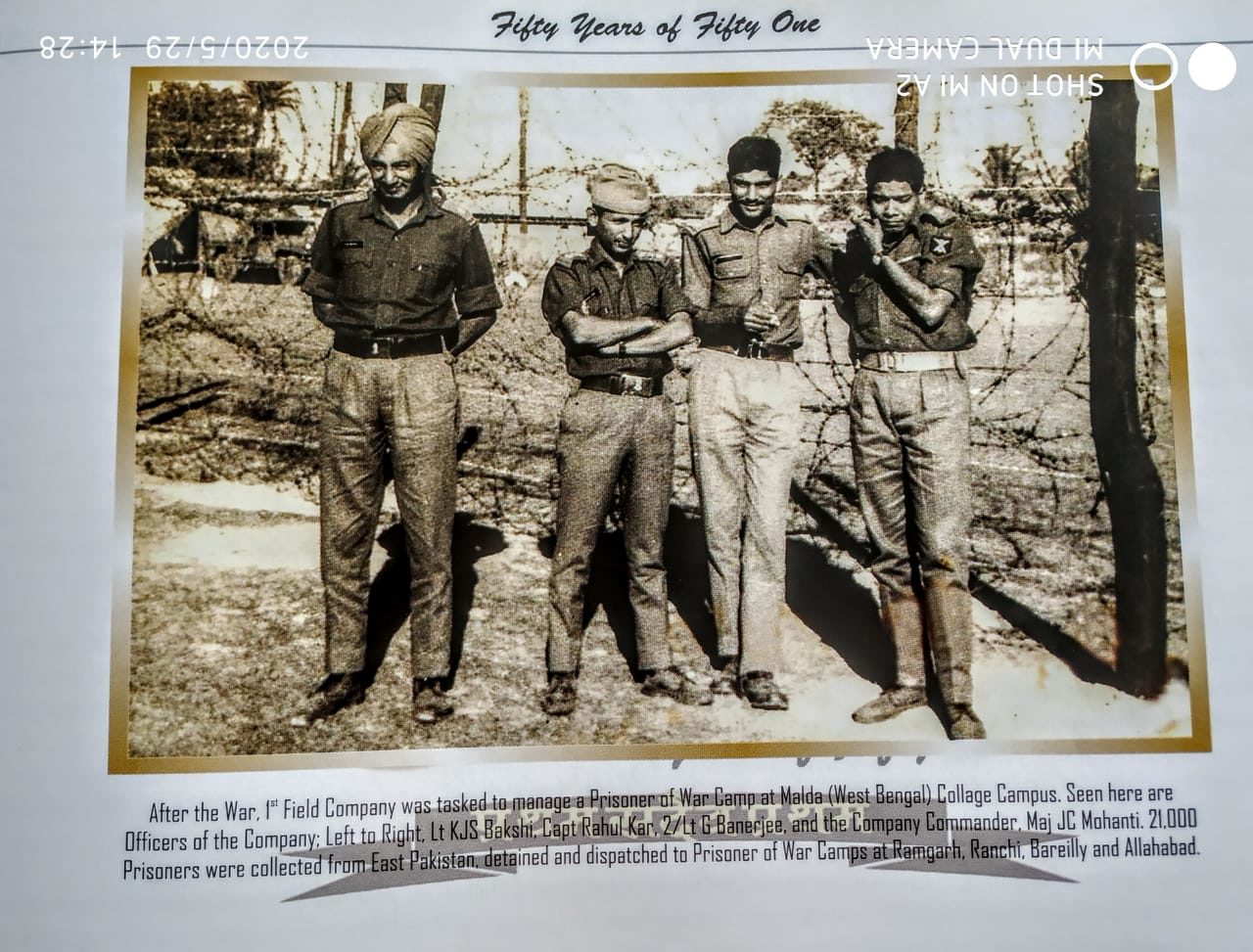
Though it turned out to be a very short re union. On 22 December Orders came again for 1 Field Company to move to MALDA for setting up and then manning a Prisoner of War Camp at MALDA.
The move began and after we had a night halt at MUZZAFARPUR, next day we were in MALDA. From 24 Dec itself the Company got busy in setting up the Prisoner of War Camp within the Malda College, located in the centre of MALDA Town.
( the story as narrated to Colonel Awadhesh Kumar, Veteran Special Forces)


